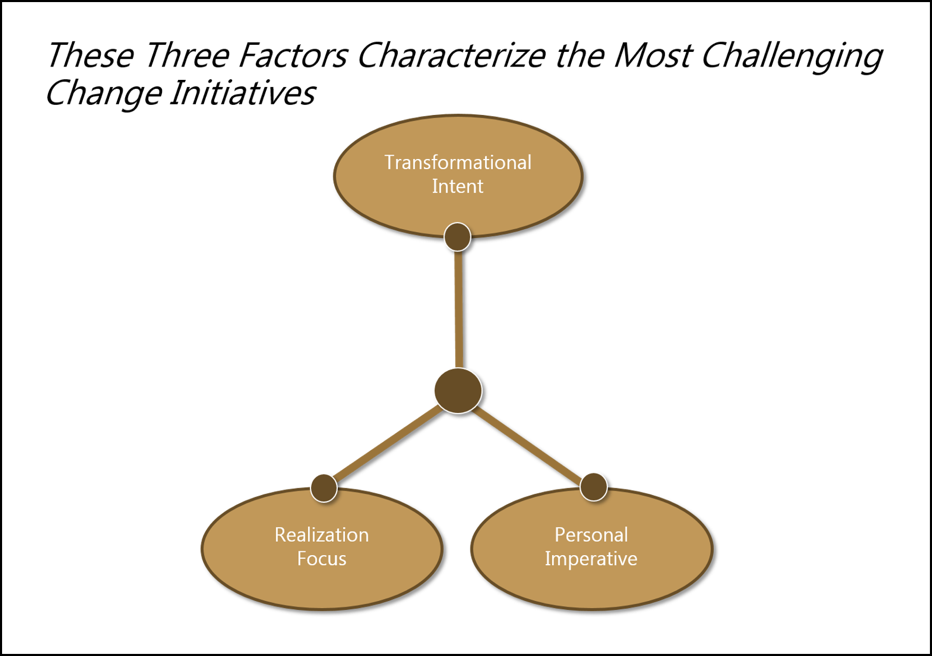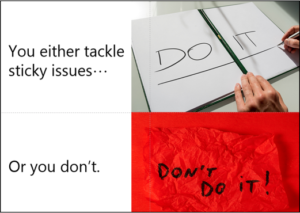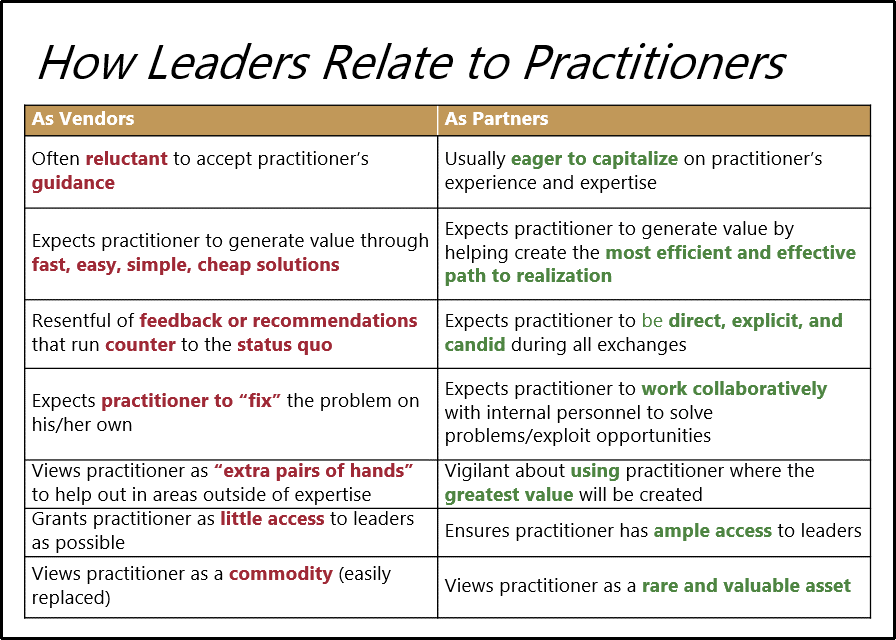Building The High Impact Trusted Advisor Relationship
High Impact Trusted Advisors (HITAs) are change practitioners with extraordinary access to and influence with senior leaders. Some serve executives at the C-suite level, some support key leaders in other capacities within the top echelon, but all are advising executives responsible for the entire enterprise, major functions, or significant geographic areas.
As they develop this level of influence, HITAs form deep interpersonal bonds with top officers and, in doing so, must be particularly attentive to certain dynamics that play out. These aren’t patterns related to the methodologies being employed, they are the underlying forces operating beneath the surface that either foster or hinder the practitioner’s ability to establish extraordinary influence. Ultimately, the success of a relationship between a leader and a practitioner is not based upon the content of the guidance being provided; rather, it depends upon the nature of the relationship within which the guidance is conveyed.
After several decades of working with change practitioners, we at Conner Academy have uncovered seven behavior/mindset patterns that contribute to or detract from succeeding in the HITA role with senior officers. They are:
- Attributes—Characteristics that differentiate HITA relationships from other types of interactions with top executives
- Success Factors—Conditions that provide a rational for the HITA relationship
- Underlying Processes—Forces operating beneath the surface that either enhance or detract from forming deep trusting relationships with senior leaders
- Necessary Mindsets—Practitioners’ frames of reference and priorities that have a bearing on their ability to successfully serve in the HITA role
- Expectations—Guidelines and processes to help establish a clear and explicit understanding of what the practitioner and leader should expect from one another in a successful advisory relationship
- Pitfalls—Common challenges, entanglements, and dilemmas that can prevent, strain, and even sever the desired rapport
- Self-Management—Perspectives and practices that cultivate the internal grounding practitioners need to serve as HITAs to senior executives
Each pattern has more than one element, as there are many facets to being a HITA to senior leaders. It would be impossible to address them all in just a few short pages (Conner Academy has an entire program dedicated to exploring these nuances!), so I have selected only a few examples to discuss below.
First Example: Success Factors
From the success factors pattern, the element I’ve selected has to do with the organizational context in which the practitioner is working. Unless the conditions are right, it doesn’t matter how skilled or experience the practitioner is, a trusted advisor relationship with a senior executive will be impossible to form.
C-suite officers and other strategic leaders aren’t looking for “just another advisory relationship” to fit into their already busy schedules. In fact, most have developed various filtering mechanisms to deal with the unending stream of people trying to get access to them. Despite this understandable need to protect themselves, top executives are not only open to but will eagerly pursue new guidance when the conditions warrant it.
The optimum situation in which a senior executive will be primed for establishing a HITA dialogue has three main attributes:
- When dramatic change is imminent and there is concern about the organization’s readiness to execute, or the change is already in play but not going as planned
- When the leader is concerned that the organization will likely install the change (build or buy a solution, introduce it to those who need to use it, train them on it, etc.), but that the fundamental purpose of the endeavor may never reach full realization and the ultimate objectives will be only partially met
- When achieving the full intent of the change becomes more than something he/she thinks is best for the organization, and achieving the desired results becomes a personal imperative for the leader
Senior leaders must feel like they are facing a period of critical change in order to justify forming a HITA alliance. To determine if this is the case, a practitioner should ask the executive three key questions when they first begin to discuss working together:
- Is the intended change transformational or incremental in scope?
- Does the desired outcome need to be fully realized, or can aspects be installed?
- Do you consider successful implementation to be a personal imperative or a hoped-for organizational result?

In my experience, it is a waste of time to attempt a deep, change-related advisory connection with top level leaders who don’t perceive one or more of these conditions to be in play (preferably, all three). In addition, trying to pursue such a relationship without the proper justification is counter-productive as far as being in position at a later time when the conditions may be more suitable. Wait until there is a pull. Don’t erode your credibility by trying to “sell” yourself prematurely, simply because it is convenient for you. HITA relationships aren’t the result of sales-centric promotions; they emerge (or don’t) based on the timing of a genuine need arising for the leader and your availability.
Second Example: Mindsets
From the mindsets pattern, the element I have chosen has to do with the role of the provocateur.
“Sticky issues” arise around certain topics, information, decisions, events, circumstances, etc. that have a bearing on the outcomes of important change initiatives, but that leaders are reluctant to discuss. Instead of exploring causes, implications, potential responses, or resolution strategies, they prefer not to bring the issues up at all or to gloss over them in a casual, superficial manner.
When HITAs are acting as provocateurs, they focus on helping leaders to recognize, acknowledge, and take action on the various “sticky issues” that inevitably arise when implementing major change. The provocateur sees his or her function as encouraging senior executives to openly address and effectively resolve the sensitive political and emotional issues that can be extremely uncomfortable to discuss, but which are vital to address in order to reach full realization of change initiatives.
It boils down to this:
- Practitioners either tackle sticky issues when they surface, or they don’t.
- When they don’t, it is usually due to ei
 ther:
ther:
- placing their own comfort and financial security ahead of what is best for the leaders they are supposed to serve, or
- lacking the kind of relationship with the leader that is needed to be influential in difficult, challenging circumstances.
If you are not functioning as a provocateur when that’s what the leader needs, you are not doing your job—it’s as simple as that.
Third Example: Pitfalls
From the pitfalls pattern, the element I have chosen deals with relating to senior leaders as a partner rather than operating as a vender.
One way to characterize the rapport between top executives and change practitioners is the degree to which trusted advisors are seen as “partners” instead of “vendors.” Vendor-type relationships develop when the leader and practitioner operate more or less autonomously and measure success in different ways. Partnerships occur when they form mutually beneficial alliances based on common goals and interdependencies.

To have a HITA relationship with top officers, it is essential that practitioners avoid being viewed as venders, and the most effective way to prevent that is to not see yourself in that light. This isn’t about applying a technique or trying to somehow manipulate the way leaders experience working with you. Quite simply, to avoid being seen as a vender, don’t think or act like one. Instead, authentically be a genuine partner to the leader you are serving.
Patterns Matter
No matter how expert HITAs may be in applying methodologies or tools, their relationships with the C-suite and other top executives they serve are what ultimately determine the success (or failure) of their change practice—and these relationships follow very definitive patterns. It is therefore crucial to remain attentive to the attributes, success factors, underlying processes, necessary mindsets, expectations, pitfalls, and self-management patterns that affect your ability to influence senior leaders. Only by recognizing and adjusting to these mindset and behavior patterns will you succeed in helping leaders to affect the change they aspire to bring to their organizations.
